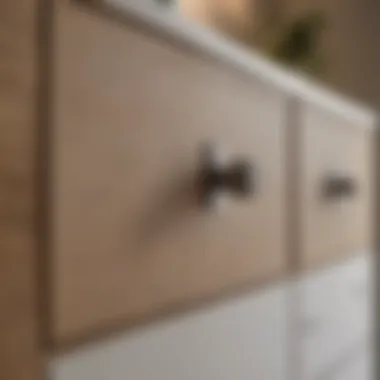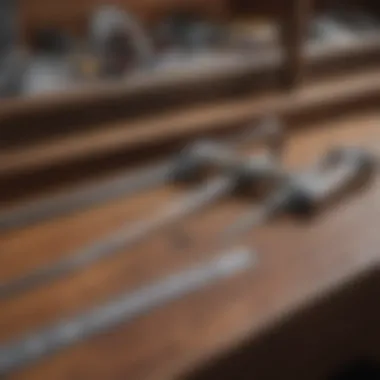Measuring for Cabinet Pulls: A Complete Guide


Intro
Accurate measuring for cabinet pulls is essential not only for functionality but also for aesthetic coherence in kitchen and furniture design. This guide focuses on the steps necessary to ensure precise measurements. Targeted towards homeowners, renters, interior design enthusiasts, and professionals, the content aims to elucidate the nuances involved in selecting and measuring for cabinet hardware. Understanding how to measure effectively can lead to a significant improvement in the overall appearance and usability of cabinetry.
A well-defined approach to measuring cabinet pulls can help avoid common pitfalls and ensure that the hardware complements the design of the space. Whether you are updating existing cabinets or installing new ones, the right measurements are pivotal in achieving a visually pleasing result.
Design Inspiration
Incorporating the right cabinet pulls is more than just a practical decision; it's a design choice that reflects personal style. The ideal pulls can set the tone for a room and bring together various design elements.
Current Trends in Interior Design
Contemporary interior design trends emphasize simplicity and cohesion. The following aspects are prevalent in modern design:
- Minimalism: Sleek, unembellished forms dominate current cabinet pull styles. Handles and knobs should blend seamlessly rather than distract from the cabinetry.
- Mixed Materials: Metal pulls combined with wood or glass are increasingly favored. This trend balances various textures, contributing to a layered aesthetic.
- Bold Colors: While traditional metallics remain popular, vibrant colors are gaining traction. Changing the cabinet pulls to a striking hue can become a focal point in any space.
Color Schemes and Palette Ideas
Choosing colors for cabinet pulls involves more than a random selection. Here are some thoughtful pairings:
- If your cabinets are in natural wood tones, opt for oil-rubbed bronze or matte black pulls to introduce contrast.
- For painted cabinets, selecting pulls in a contrasting color can enhance visual interest. For example, white cabinetry may benefit from navy blue or deep green pulls.
- Neutral-tone hardware can be an excellent choice for a monochromatic palette, allowing other design elements in the room to shine.
Potential combinations are endless, yet clarity in purpose and style will yield the best results.
"In design, every small detail matters. The right cabinet pull can transform the whole look of your cabinetry."
Investing time in measuring for cabinet hardware enables a tailored approach. This guide will further expand on the practical aspects of measurement, ensuring your selection aligns with both your design vision and functional needs.
Preamble to Cabinet Pulls
Cabinet pulls are not merely functional elements; they are essential in defining the overall aesthetic of a kitchen or furniture piece. Selecting the right cabinet pulls can enhance both style and usability in a space. The blend of form and function is crucial for an inviting and efficient design. This section aims to lay the groundwork by explaining cabinet pulls, their significance, and the paramount need for precision in measurements when fitting these accessories.
Definition and Purpose
Cabinet pulls are hardware fittings that facilitate the opening and closing of cabinets and drawers. They come in various styles—ranging from sleek and minimalist to ornate and classical. The primary purpose of cabinet pulls is to provide a grip point, easing the accessibility of kitchen items or stored belongings. This functionality is significant, as it directly affects the user experience.
The definition of cabinet pulls encompasses more than just their physical presence. They serve as an opportunity for personalization, allowing homeowners to express their individual style. Customization options abound, from material choices to finishes, expanding design possibilities. Whether renovating a kitchen or just updating a furniture piece, cabinet pulls can significantly influence both the practical and visual aspects of the space.
Importance of Accurate Measurement
Precision in measurements is a non-negotiable step in the selection and installation of cabinet pulls. Accurate dimensions ensure that the pulls are not only aligned properly but also fixed securely to withstand daily use. Miscalculations can lead to unsightly gaps or overlaps, detracting from the overall appeal.
Proper measurement impacts several aspects of the design. For instance, the spacing between multiple pulls must be calculated carefully to maintain a uniform look. Overly tight or loose spacing can create discomfort when using the cabinetry and affect its visual balance.
Additionally, the height at which cabinet pulls are placed is essential for ergonomics. An ideal height enhances accessibility for users of different ages and heights. Installing pulls too high or low can lead to frustration and compromise usability. Accurately measuring these factors ensures that the pulls not only look good but also function well in everyday situations.
"The right measurements serve as a foundation for a successful installation. Neglecting this step can render your efforts meaningless."
Furthermore, homeowners and designers benefit from understanding the standard sizes available. This practice allows for easier selection of hardware that best fits existing cabinetry without extensive modifications. By taking a methodical approach to measuring, the overall experience can be greatly improved, leading to a cohesive and attractive final product.


Types of Cabinet Pulls
Understanding the different types of cabinet pulls is crucial for achieving both functionality and aesthetics in your interior design. Each style has its own characteristics, and the right choice can significantly enhance the overall look of your cabinets. It is important to consider the ease of use, style compatibility, and the tactile experience of each type when making a selection.
Bar Pulls
Bar pulls are long, straight handles that can provide a contemporary look to any cabinetry. They come in various lengths, widths, and finishes, such as brushed nickel, matte black, or polished chrome. When selecting bar pulls, it is important to consider the scale of your cabinets. Longer pulls can give a dramatic effect and may be especially suitable for larger cabinet doors, while shorter pulls may work better for smaller drawers.
The key benefits of bar pulls include:
- Modern Aesthetic: They complement contemporary kitchen designs and minimalist aesthetics.
- Ease of Use: Their elongated shape provides a comfortable grip, making them practical for daily use.
- Variety: There are many options available, which allows for customization based on your specific design goals.
Cup Pulls
Cup pulls are defined by their recessed shape, resembling a small cup where fingers can grip comfortably. These pulls are often found on drawers and cabinets in traditional or vintage settings, adding a nostalgic touch to interiors. Common finishes for cup pulls include antique brass, oil-rubbed bronze, and polished stainless steel.
When incorporating cup pulls into your design, consider the following aspects:
- Style Compatibility: Cup pulls tend to fit well in rustic and vintage spaces, making them ideal for farmhouses or period-style homes.
- Comfort: They are easy to grip and pull, making them functional for large drawers that require more force.
- Installation: Proper placement is key, as cup pulls should be mounted in a way that aligns well with the cabinet’s edge for an integrated look.
Knobs vs. Pulls
Choosing between knobs and pulls can be a significant decision in the cabinetry design process. Both options serve a functional purpose but differ greatly in appearance and application. Knobs are often more compact and simple, while pulls provide a larger surface for gripping.
Key considerations in this decision include:
- Cabinet Size: Larger cabinets may benefit from pulls for ease of handling, while smaller cabinets might suit knobs better.
- Design Theme: A consistent style across hardware is essential; knobs can provide a more subtle look, while pulls tend to be more noticeable.
- Functionality: Analyze how often the cabinets will be used. For frequently accessed cabinets, pulls may offer a better user experience.
In summary, understanding the types of cabinet pulls available allows for enhanced functionality and a polished design. The choice between bar pulls, cup pulls, and knobs can dictate the overall aesthetic, making thoughtful consideration essential in the selection process.
"The right cabinet hardware can transform your space, both functionally and visually."
By taking the time to evaluate the options, you ensure your cabinetry not only looks great but also serves your practical needs effectively.
Necessary Tools for Measuring
Accurate measurement is crucial when selecting and installing cabinet pulls. The tools used for this task not only affect the precision of the measurements but also enable a smoother installation process. This section details the essential tools required for measuring cabinet pulls, outlining how each contributes to achieving the desired results in both form and function.
Measuring Tape
The measuring tape is perhaps the most fundamental tool in the process of measuring for cabinet pulls. It provides a flexible yet reliable means to gauge dimensions accurately, whether it's the width of a cabinet door or the distance between drill holes.
Using a measuring tape allows for quick and easy measurements. Make sure to select a tape that is at least 25 feet long, as this is typically sufficient for standard kitchen cabinetry. If you are working in larger spaces, a longer tape might be necessary. The markings on the tape should be clear, with measurements in both inches and millimeters to cater to different hardware standards.
When measuring for cabinet pulls, it’s important to avoid pulling the tape too tightly as this may cause the reading to be slightly off. Hold the tape flat against the surface while measuring. Moreover, double-check each measurement before proceeding.
Level
A level is another key instrument in the measurement process. It ensures that the cabinet pulls are installed horizontally or vertically with precision. An uneven pull can disrupt the overall appearance and functionality of the cabinetry.
To use a level effectively, place it on the surface where the pulls will attach. Adjust the position until the bubble inside the level rests in the center. This indicates that your measurements are aligned correctly. Using a level is especially important if you are installing multiple pulls, as misalignment can become obvious if not properly checked at each stage. Investing in a good quality level can save much hassle later on in the installation.


Pencil and Paper
Though often overlooked, a simple pencil and paper can drastically improve the measurement process. Jotting down measurements allows for easy reference and reduces the chance of errors amidst the chaos of installation.
In addition to writing down measurements, sketching the layout can be beneficial. This way, you visualize where each pull will go, ensuring that spacing is both aesthetically pleasing and functional. A pencil allows you to make marks directly on the cabinet surface, which can later be easily erased or adjusted based on further assessment.
In summary, the combination of a measuring tape, a level, and the use of pencil and paper streamlines the process of measuring for cabinet pulls. They help to ensure that measurements are accurate, aligned, and documented properly. Each tool plays a unique role, but together they form a cohesive strategy for a successful installation.
Standard Sizing for Cabinet Pulls
Understanding the standard sizing for cabinet pulls is crucial when making selections for your kitchen or furniture. Correct sizing not only ensures a stylish appearance but also improves usability. This section will cover common dimensions and the differences between stock and custom sizes.
Common Dimensions
Cabinet pulls come in various sizes, but certain dimensions are prevalent in the market. The most common width ranges from three to twelve inches. This size depends on the type of cabinetry and the space available. Length can significantly impact the visual appeal and functionality of a kitchen or furniture piece.
Pulls typically range from three to five inches in spacing between holes. This measurement is vital for compatibility with cabinets. Following are some standard sizes of cabinet pulls:
- 3 inches: Common for smaller cabinets.
- 4 inches: Provides a balanced look on medium-sized drawers.
- 5 inches: Often used for larger drawers or cabinets.
- 12 inches and above: Suitable for contemporary designs that require more substantial hardware.
It is essential to measure your cabinets accurately before selecting the pull size. Otherwise, you might end up with hardware that looks disproportionate.
Stock vs. Custom Sizes
When considering cabinet pulls, you'll encounter the terms stock and custom sizes. Stock sizes are pre-manufactured options widely available in stores, while custom sizes are made to order, tailored to fit specific needs.
Choosing stock sizes can expedite your project, as these options are readily available at home improvement stores. They come in standard finishes and designs that suit most interiors.
On the other hand, custom pulls offer the benefit of uniqueness. You can specify dimensions and finishes to match your personal style or the specific requirements of your cabinetry. However, this option often comes with a higher cost and longer lead time.
"Selecting the right pull size is vital for both aesthetics and functionality."
Planning Measurements
When considering cabinet pulls, planning measurements is a crucial step that can significantly affect both the aesthetics and functionality of the space. Proper planning ensures that every element is aligned correctly, contributing to an overall harmonious design. Effective measurement plays a role in achieving visual balance and user comfort, aspects that are often overlooked during the design process.
Height and Placement
The height and placement of cabinet pulls require thoughtful attention. The height at which a pull is installed can influence ease of use. Typically, cabinet pulls should be positioned between 2.5 to 3 inches from the top of the cabinet doors. This range provides a comfortable grip for most users, reducing strain during daily use. When planning the placement, consider who will be using the cabinets most often. For tall individuals, a higher placement might be preferable, while shorter users might benefit from a lower position.
Placement should also take into account the overall design scheme. Aligning pulls with other elements such as drawer fronts or cabinet doors enhances visual coherence. Additionally, ensure that there is enough space around the pull for fingers to grasp comfortably. This may require some trial and error, especially in kitchens or high-traffic areas.
Spacing Between Pulls
The spacing between cabinet pulls is as important as their height. When installing multiple pulls on a side-by-side basis or on drawers, the distance can affect both functionality and appearance. A general rule of thumb is to leave at least 3 to 4 inches between the center of one pull and the next. This allows for comfortable access and minimizes the risk of bumping into adjacent pulls, which can be a common annoyance in tight spaces.
When dealing with larger drawers or cabinets, consider using multiple pulls for better distribution. This not only enhances the aesthetic but also provides a more ergonomic solution. Also, ensure that pulls are evenly spaced, creating a clean and organized look. Uneven spacing can lead to a chaotic appearance, undermining the whole design.
"Proper planning of measurements can save you time and excessive adjustments later on, allowing for a smoother installation process."
Installation Considerations


In the realm of cabinet pulls, the process of installation goes beyond simple hardware attachment. It is a critical phase that ensures both functionality and visual appeal. Understanding the nuances of installation can greatly influence the overall user experience, satisfaction, and durability of the pulls. It's essential to consider how the placement of cabinet pulls can affect ergonomics and ease of use, particularly in frequently accessed areas.
Proper installation of cabinet pulls can enhance the aesthetic of the cabinetry while ensuring that the hardware operates effectively. Misalignment or incorrect placement can lead to frustration during use, diminishing the satisfaction of your kitchen or furniture design. Therefore, taking the time to understand installation considerations is vital for achieving optimal results.
Drilling Holes
Drilling holes is a fundamental aspect of installing cabinet pulls. This process requires precision and care. Incorrect drilling can result in uneven pulls, making them difficult to use and visually unappealing. Here are some key points to consider:
- Measurement Accuracy: Before drilling, double-check your measurements. You should clearly mark where each hole goes on the cabinetry for accuracy. A small mistake can affect the entire installation.
- Choosing the Right Drill Bit: Different pulls may require different sizes of holes. Ensure that you use the correct drill bit size to accommodate the screws of your specific cabinet pulls.
- Leveling: It is important to ensure that your drill is perfectly leveled to avoid crooked holes. Use a level if necessary, especially for larger installations.
- Material Considerations: The type of material you are drilling into will also affect your approach. For example, drilling into wood is different than drilling into metal or composite materials, so select drill bits accordingly.
"Accurate drilling not only ensures proper fit but also preserves the integrity of the cabinetry."
Securing Hardware
Once the holes are drilled, the next step is securing the hardware. This aspect of installation is just as crucial as the drilling process. Properly secured pulls will endure daily usage without loosening over time.
- Using the Right Screws: Different cabinet pulls come with specific screws, often suited for their construction. Make sure you are using the screws that accompanied your pulls for a secure fit.
- Using Anchors if Necessary: For heavier pulls, it is advisable to use wall anchors, especially if the cabinetry is not sufficiently sturdy. This will prevent the pulls from pulling away from the surface.
- Tightening: Once the pulls are in place, double-check that all screws are tightened. Loose screws can lead to misalignment and can easily result in hardware damage over time.
- Regular Checks: After installation, it’s wise to routinely check the pulls for tightness. This is particularly important in high-use areas where the hardware might experience significant wear.
By carefully considering the aspects of drilling and securing the hardware, one can ensure an effective and visually pleasing installation of cabinet pulls.
Common Mistakes to Avoid
Mistakes in measuring for cabinet pulls can lead to functionality issues, aesthetic problems, and ultimately dissatisfaction with the final results. Understanding what common errors to avoid is crucial for ensuring that the hardware installation is both practical and visually appealing. This section highlights the major pitfalls that can arise during the measuring process, along with specific considerations for each mistake to prevent delays and frustrations.
Ignoring Ergonomics
When selecting and placing cabinet pulls, ergonomics play a vital role. Ignoring how users will interact with pulls can result in poor usability. Ergonomics refers to designing the space in a way that is comfortable and efficient for the users. Consider the height at which cabinet pulls will be mounted. If they are placed too high or too low, users may strain themselves when reaching for them.
Planning the height of pulls involves understanding the average reach of the individuals who will use the cabinets. It’s recommended to position pulls at a height of 36 to 42 inches from the floor, taking into account the user demographics. Does your household have children? Older adults? Adjust according to their needs.
Poor Spacing
Spacing between cabinet pulls is another common oversight. Poorly spaced pulls can disrupt the flow and create a cluttered appearance. When measuring for spacing, it's crucial to maintain a consistent distance between pulls. For cabinets with multiple pulls, consider a typical spacing of 2 to 3 inches between each pull.
Uneven spacing may irritate the visual symmetry of the cabinet design and diminish functionality. A good rule of thumb is to use a template or mark the points before drilling. This simple step can help visualize the final arrangement and reduce errors during installation.
Incorrect Hole Placement
Accurate hole placement is crucial for a smooth installation and operation of cabinet pulls. One common mistake is miscalculating the distance between the holes or marking them in the wrong position. It may seem trivial, but drilling holes incorrectly can lead to major issues, including the inability to align pulls properly.
To prevent inaccurate hole placement, measure twice before drilling. A good practice is to measure from the center of each pull to the edge of the cabinet door or drawer. Use a level to ensure that the drill marks are horizontally aligned. This attention to detail can save significant time and effort during installation and can ensure a professional look once complete.
Always prioritize careful planning and measuring for the best end results. Remember, well-placed cabinet pulls not only enhance the aesthetics but also contribute to the functionality of your cabinets.
Epilogue
Measuring for cabinet pulls is not merely a task, but a critical element in both design and functionality within any space. Accurate measurement ensures that the pulls fit correctly and appeal visually, enhancing the overall aesthetic of furniture or cabinetry. Neglecting this aspect can lead to misalignment, uncomfortable use, and can diminish the style of the entire area.
Recap of Key Points
In this guide, we have explored several key aspects regarding measuring for cabinet pulls:
- Types of Cabinet Pulls: Understanding the variety of options available helps in making informed decisions.
- Necessary Tools for Measuring: Tools like measuring tapes and levels are essential for precision.
- Standard Sizing: Awareness of common dimensions aids in selecting the right fittings.
- Planning Measurements: Correct placement and spacing promote ergonomic use and visual harmony.
- Installation Considerations: Knowing how to properly drill and secure hardware prevents future issues.
- Common Mistakes to Avoid: Recognizing pitfalls like ignoring ergonomics or poor spacing will save time and resources.
Final Thoughts on Cabinet Pulls
When choosing cabinet pulls, it’s essential to remember that they are not just functional elements; they contribute significantly to the design narrative of any space. By measuring accurately and considering every detail, you can enhance both the practical and aesthetic components of your cabinets. Each cabinet pull tells a story and reflects personal style, making your approach to their selection and installation vital to your project's success. This guide aims to elevate your understanding and help you make wise decisions in your home or professional designs.



